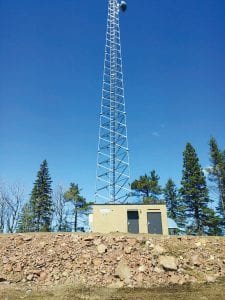Cook County Information Technology (IT) Director Rena Rogers said the three proposed allied radio matrix emergency response (ARMER) radio towers that will be built near Sawbill Lake, Cascade River and Devilfish Lake this fall offer more than just emergency radio communications.
“For the first time people living near these areas will have a chance to hook up to power and receive fiber optics if they choose to,” she said.
Another plus is that the state has decided to keep towers at 180 feet so no lights will have to be installed on them, said Rogers.
Towers 200 feet tall and taller must be lit so airplane pilots can see them. But that also means that everyone within miles around can also see the lit beacons, which often annoys people who are trying to live in or get a true wilderness experience.
Also, said Rogers, instead of having overhead electrical lines on poles, power lines will be trenched in and buried wherever possible to keep maintenance low and line clutter out of sight.
Because the cost to install electricity is high and usually borne by the people living in the immediate area— and few people live in these area— these places haven’t had access to the electrical grid.
However, said Rogers, the state will pick up the price and Arrowhead Electric will bring services to people if they choose to become electric customers.
The Minnesota Department of Natural Resources (DNR) will need to obtain 62 easements to run lines along the proposed routes. The Cascade tower will pick up power from near Devil Track Lake and the line will run past Thompson Lake.
Electricity for the Devilfish Tower will come off a junction box near the old Tom Lake Road and run several miles before reaching the tower site.
The Sawbill tower will run a line from a junction box near the end of the Sawbill Trail past Gust Lake to the tower site.
Just because power will run past an individual’s home or cabin, it doesn’t mean their property will be assessed at a higher value unless they hook up to it, said Rogers.
Two public meetings will be held to discuss the towers on May 12. The first will be conducted at the Cook County courthouse from 4 to 5 p.m. in the commissioners’ room and the second will be held at the Hovland Town Hall at 6 p.m.
Rogers and Cook County commissioners whose constituents will be affected by the towers will attend the meetings as well as Cook County Sheriff Pat Eliasen to answer questions and concerns.
The Minnesota Department of Transportation (MnDOT) owns and operates the ARMER system. It is administered in coordination with the Statewide Emergency Communications Board and the Department of Public Safety. The goal is to have at least 95 percent emergency radio coverage throughout the state.



Leave a Reply